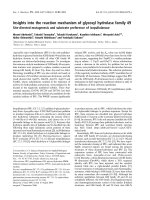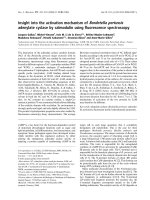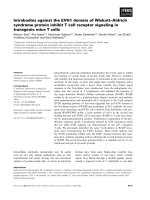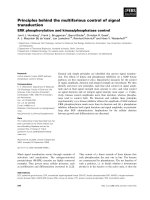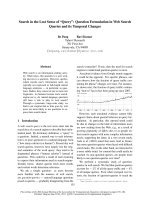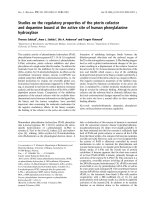Báo cáo " Scientific bases for defining the coastal zone of Quang Binh, Quang Tri, Thua Thien Hue provinces " potx
Bạn đang xem bản rút gọn của tài liệu. Xem và tải ngay bản đầy đủ của tài liệu tại đây (148.24 KB, 11 trang )
VNU Journal of Science, Earth Sciences 26 (2010) 8-18
8
Scientific bases for defining the coastal zone of
Quang Binh, Quang Tri, Thua Thien Hue provinces
Nguyen Hieu*, Nguyen Cao Huan, Dang Van Bao
Hanoi University of Science, VNU, 334 Nguyen Trai, Hanoi, Vietnam
Received 8 September 2010; received in revised form 15 October 2010
Abstract. Vietnam has more 3000km of coastline and the features of the coastal zone in various
areas (Northeast area, Red River Delta, Central Region and Mekong River Delta) are also
different. Therefore, it is necessary to study specific characteristics of each area and find out the
suitable boundaries for the coastal zone.
The legal basis related to Vietnam’s territorial sovereignty on the sea, the typical natural
resources of the Quang Binh - Quang Tri - Thua Thien Hue coastal zone (Quaternary sand
terraces, sand dunes, lagoons, sea grass, coral reef…), administrative organization, project ability,
the capacity of data inheritance, and the experiences of successful ICZM projects in Vietnam and
in the world, all are scientific bases for defining the coastal zone of Quang Binh, Quang Tri, Thua
Thien Hue provinces in general and the study area of project KC 09.08/06-10 in particular. The
landward portion of the study area includes 206 communes of Quang Binh, Quang Tri, Thua Thien
Hue provinces that have their entire or most area located east of the 25m contour line. The seaward
boundary of the project study area is found mainly along the 30m isobath. The boundary is
extended to the 50m isobath (the limit of coral ecosystem distribution) around Con Co Island. The
total study area of the project KC 09.08/06-10 is 9,837 km sq.
Keywords: Coastal zone, Integrated Coastal Zone Management, Quang Binh, Quang Tri, Thua Thien
Hue.
1. Introduction
1
The coastal zone is a special and important
part of the Earth’s surface, the contact place
between the spheres: lithosphere, biosphere,
hydrosphere, and atmosphere of the Earth but
also the place that contains ecosystems with the
highest productivity, richness and biodiversity.
Since a long time ago, the coastal zone,
especially the estuarine region, has become
places for crowded human exploitation and
_______
* Corresponding author. Tel.: 84-4-38581420.
E-mail:
residence. The trend of seaward migration from
land areas is ever increasing and occurs
globally. According to the Green Cross
Australia’s latest statistics, in 1999, when the
world population reached 6 billion, about 240
million people lived in cities located in the
coastal zone. To date, as the world population is
estimated at approx. 6.7 billion, up to 634
million people live and about two thirds of
cities with more than 5 million population are
built in the coastal zone, within 10m elevations
above sea level. In Vietnam, by 2005 about
41.4 million people lived in the land strip with
N. Hieu et al. / VNU Journal of Science, Earth Sciences 26 (2010) 8-18
9
the elevation of 10m or less (ranked 5
th
place in
the world’s 10 countries) accounting for
approx. 53% of the country’s total population
(ranked 8
th
in the 10 countries with the highest
proportion)
Also due to such importance, rich coastal
natural resources have become priceless asset,
object of special interest for studies,
exploitation and use, and management in
marine states. However, due to complexity of
natural, social processes in the coastal zone,
legal constraints as well as difficulties,
limitations in the study process, determining the
coastal zone boundaries for management is also
very diverse. Depending on research objectives
of programs or projects, management strategies,
the extent of the coastal zone is also determined
in different ways or scales.
One of the important research contents of
the State Project under Marine Science and
Technology Program coded KC09.08/06-10
“Scientific arguments on the coastal zone
management and sustainable development
model of Quang Binh, Quang Tri, Thua Thien
Hue provinces” is to define the extent of the
coastal zone within three provinces in general
and depending on the specific conditions to
determine the study space of the project.
Following are some results of this research
content.
2. The concept of coastal zone: conception
and limits
The boundary between the sea and land
does not appear as a clearly defined map line, it
is a gradual transition strip of land and water.
This strip of land and water is named coastal
zone or coastal area [1]. This is a special and
important part of the Earth’s surface, where
there is a gradual transition between the sea and
land, the Earth’s spheres meet: lithosphere,
biosphere, hydrosphere, and atmosphere, and
contains ecosystems with the highest
productivity, richness and biodiversity.
Natural definition of the coastal zone
Generalized and widely used is the
definition of the coastal zone in interaction
between sea and land environments: “A coastal
zone is a transition region where sea and land
interact and shape an unified environment”
(Barbara E. Brown, 1997) [2]. In theory, the
definition shows a complete nature of the
coastal zone, as a specific space where the
natural environment bears specific
characteristics of the combination between
marine and terrestrial environments,
simultaneously highly generalized. This is also
a definition used by many books on the natuarl
environment of coastal zones.
Based on the integrated and system view,,
Lymarev V.I. defined “a coastal zone (or also
called interaction zone between sea and land) is
an adjacient land-sea band not very large with a
particular nature making up a component of the
Earth’s landscape and a place where there is a
complex and contrary interaction between
lithosphere, atmosphere, hydrosphere and
biosphere”.
For geomorphological science, a coastal
zone is regarded as an interaction place between
land and sea to form its paticular landforms.
Here, sea waves and all kinds of currents
generated by them are dynamic elements very
important to landform formation and
modification as well as sedimentation. In
addition, elements such as tide, river, current,
wind, organism also play an important role.
The lower limit of the coastal zone is the depth
at which waves start to be deformed, as well as
topography and bottom sediments start to be
altered. That depth is determined to be half the
N. Hieu et al. / VNU Journal of Science, Earth Sciences 26 (2010) 8-18
10
wave length. And the landward limit of the
coastal zone is determined to be the line of peak
climbing wave. This applies to open sea areas,
also the coastal zone has a land strip frequently
impacted by other marine factors such as tide,
salinity, current These are semi-closed or
closed waters but connected with bays, lagoons
and estuaries [3]. These formations are
considered the components of a complete
coastal zone.
Definitions in the study of coastal zone natural
resource exploitation, use and management
policy making
Coastal zone management involves
continuosly managing coastal zone resource
use, hence the boundary of the coastal zone is
usually defined with caution for management
and executive activity (Jones và Westmacott,
1993). As far as management policy making is
concerned, the coastal zone space is usually
defined in 4 ways as follows: 1) fixed distance
definitions, 2) variable distance definitions; 3)
definitions according to use; or 4) hybrid
definitions (Kay R. and Alder J., 2005) [1].
Following fixed distance definitions along
the coastline, a zone in which natural elements
of the coastal zone are concerned, is calculated
from some boundary between sea and land –
usually by the mean tidal level. The seaward
limit is usually taken as the limit of the national
sovereignty extent.
As for fixed distance definitions, the coastal
zone space defined by variable distance is also
defined by some boundary between sea and
land. The only difference is that the boundary
distance is not fixed along the coast, but varies
according to variables: physical features (e.g.
the landward limit of Holocene sand dunes, or
the seaward limit of submarine platforms);
biological features (e.g. the landward limit of a
coastal vegetation complex, or the seaward
limit of a fringing reef); constructed landmarks
(e.g. roads, canals, or well known buildings); or
administrative boudaries (e.g. the landward
limit of marine localities) [1].
International organizations and large coastal
nations often define the limits of the coastal
zone according to specific management issues,
for example for marine pollution management
purposes, defining the limits of the coastal zone
must take into account the whole catchment and
its associated groundwater.
In summary, there is no exact definition of
the coastal zone and its extent. All definitions
try to take into account both coastal, estuarine
areas and the entire land portion extended along
the coast on which natural and human processes
act and are affected. The limits of a coastal zone
can be very large, defined not only by
ecological features, but also depend on policy
terms and authority management ability. The
extent of the coastal zone can be only a narrow
border band between land and sea that is from
some meters to some kilometers large, but
sometimes the boundaries are widened
landward to the divide of river basins flowing
into the sea and seaward to the whole national
special economic zone.
Natural products of the coastal zone become
real resources with human actions. These
actions have direct impact on coastal zones
through the relationship between the coastal
zone system and its surrounding systems.
Coastal zone management arises from human
impacts on coastal zone systems with the
purpose of protecting and developing coastal
zone resource systems (Figure 1).
N. Hieu et al. / VNU Journal of Science, Earth Sciences 26 (2010) 8-18
11
Figure 1. Relationship between coastal zone and coastal zone resource system (Chua, 2001) [4].
This was the Declaration on May 12, 1977
of the SRV’s Goverment on the territorial seas,
adjacient areas, special economic zone,
continental shelf and islands located within
these sea areas. According to this declaration,
Vietnam’s marine territory has a width of 12
miles calculated from the baseline; adjacent
areas are also 12 miles wide from the territorial
sea; the territorial sea and adjacent areas have a
width of 24 miles calculated from the baseline;
the special economic zone is 200 miles wide
calculated from the baseline; the continental
shelf is the sea bed portion and the ground
under seabed extended to the outer margin of
the continental shelf, where the continental
shelf margin is nearer, the continental shelf is
widened to 200 miles calculated from the
baseline. At present, Vietnam is using this
scheme to orient all activities of scientific
research, socio-economic development and
maintaining sovereign security on its sea and
island areas.
Next, there was the declaration dated Nov.
12, 1982 on the baseline used to calculate the
width of Vietnam’s territorial sea and other sea
areas. According to this declaration, the
baseline of Vietnam is a straight baseline
consisting of 11 điểm points and 10 segments
starting from Tho Chu Island to the last point of
Con Co Island. Next, the Law of the National
Border was passed by the National Assembly
on June 17, 2003.
And Vietnam’coastal zone in the Gulf of
Tonkin was defined in the Vietnam-China
Agreement on the territorial sea, special
economic zone and continental shelf
delimitation in the Gulf of Tonkin signed on
25/12/2000 and ratified by the 11th Session
National Assembly of the Socialist Republic of
Vietnam on 15/6/2004. According to this
Treaty, the delimiting line consists of 21 points
with defined geographic coordinates
sequentially connected in segments with
different lengths (Table 1, Figure 2). The
delimiting line goes 15 miles east of Bach Long
Vi Island calculated from the most protruding
point of the island and Point 21 located in the
middle of the segment connecting from Oanh
Ca cape of Hainan Island to Con Co Island
(Figure 2). In accordance with this delimitation
line, Vietnam manages 53.23% and China
46.77% of the Gulf area.
Terrestrial
Environment
Marine
Environment
Human
Activities
Coastal zone
Coastal resource system
N. Hieu et al. / VNU Journal of Science, Earth Sciences 26 (2010) 8-18
12
Figure 2. Line delimiting the Gulf of Tonkin between Vietnam and China.
N. Hieu et al. / VNU Journal of Science, Earth Sciences 26 (2010) 8-18
13
The limits of the coastal zone proposed by
sectors, programs of management, use and
exploitation research
The definition of Vietnam’s coastal zone
seaward boundary according to the 1982 UN
Convention on the Law of the Sea and
international rules by the Government aims to
affirm sovereignty and formulate national
strategies, policies for management,
exploitation and use of natural resources. In this
case, the coastal zone is understood as part of
the national territory spatially planned for
implementing management policies. During the
deployment of national, ministerial and
sectorial programs and projects, the the coastal
zone space is defined again specifically to
comply with research objectives and contents as
well as financial and technological capacities.
The criteria for defining the coastal zone in
our country include natural resources, social
management and legal administration.
However, so far there has been no agreement
between ministries, sectors on the boundaries of
Vietnam’s coastal zone. Practically, this
agreement is very difficult to reach, since as
mentioned in heading 2, the definition of the
coastal zone limits is very flexible and there are
many different ways to do it.
Vietnam has a territory stretching
latitudinally with more than 3000km of
coastline. There are two large deltas formed by
the Red and Mekong rivers in the north and the
south together with the continental shelf
extending seaward. In central Vietnam,
mountainous and hilly landforms are found
close to the sea with narrow plain strips and the
continental shelf right near the coast. With such
features, the definition of a common boundary
for the national coastal zone requires a
combination of many different criteria.
Proposals relating to the coastal zone boundary
have already been made by some ministries,
sectors, for example the landward boundary,
according to the National Environmental
Protection Agency, is taken as the boundary of
district with marine features, and seaward,
according to the Ministry of Fisheries, in
northeast, south Vietnam and the Gulf of
Thailand as the 30m isobath, in central Vietnam
as the 50m isobath [5]. Recently, in accordance
with Decision No. 158/2007/QĐ-TTg dated
October 9, 2007 by Prime Minister approving
“Program on integrated management of north
central coastal zone and central coast until
2010 and orientations until 2020” (including 14
coastal provinces from Thanh Hoa to Binh
Thuan), the seaward boundary is calculated 6
miles of the coast, and landward the boundary
of all coastal districts of the provinces in the
region.
Taking the landward boundary based on
marine districts is logical, since they are
independent administrative units, easy to
implement institutions, management policies.
However, during the process of boundary
definition, besides management elements
physical features of the coastal zone,
specifically coastal zone natural resources
should be considered. In the north and the
south, if the boundary is taken as the natural
one, for example, the boundary of Quaternary
landforms of marine and fluvio-marine origin,
the coastal zone boundary will be very deep
landward, thus, taking the boundary by marine
districts is reasonable since it harmonizes both
criteria of management and coastal zone typical
natural resources. But this way applied to
Central Region or northeast region (in Quang
Ninh province) will face difficulties in the
assessment of coastal zone resources. The
boundary of some districts such as Hai Ninh,
Quang Ha, Tien Yen (Quang Ninh) or Bo
Trach, Quang Ninh, Le Thuy (Quang Binh),
Vinh Linh, Gio Linh (Quang Tri) also covers a
large area of hills and mountains.
N. Hieu et al. / VNU Journal of Science, Earth Sciences 26 (2010) 8-18
14
Table 1. Geographic coordinates of delimitation points in the Gulf of Tonkin
1 Point No. 1: 21°28'12".5 N, 108°06'04",03 E 12 Point No. 12: 19°39'33" N, 107°31'40",00 E
2 Point No. 2: 21°28'01".7 N, 108°06'01",06 E 13 Point No. 13: 19°25'26" N, 107°21'00" E
3 Point No. 3: 21°27'50".1 N, 108°05'57",07 E 14 Point No. 14: 19°25'26" N, 107°12'43",00 E
4 Point No. 4: 21°27'39".5 N, 108°05'51",05 E 15 Point No. 15: 19°16'04" N, 107°11'23",00 E
5 Point No. 5: 21°21'28".2 N, 108°05'39",09 E 16 Point No. 16: 19°12'55" N, 107°09'34",00 E
6 Point No. 6: 21°27'23".1 N, 108°05'38",08 E 17 Point No. 17: 18°42'52" N, 107°09'34",00 E
7 Point No. 7: 21°27'08".2 N, 108°05'43",07 E 18 Point No. 18: 18°13'49",00 N, 107°34'00" E
8 Point No. 8: 21°16'32",00 N, 108°08'05",00 E 19 Point No. 19: 18°07'08",00 N, 107°37'34",00 E
9 Point No. 9: 21°12'35",00 N, 108°12'31",00 E 20 Point No. 20: 18°04'13",00 N, 107°39'09",00 E
10 Point No. 10: 20°24'05",00 N, 108°22'45",00 E 21 Point No. 21: 17°47'00" N, 107°58'00" E
11 Point No. 11: 19°57'33",00 N, 107°55'47",00 E
The definition of seaward boundaries is also
very cautious, taking into account sovereignty,
legality, physical features, natural resources and
ability to deploy management programs,
projects. First of all one must affirm that for
sovereignty and long term management
strategies, Vietnam’s coastal zone boundaries
are taken seaward to cover the entire special
economic zone. And step by step in
management strategies or depending on
programs, research projects deployed one can
adjust the boundary to comply with the
objectives and technological capacity of marine
research. The seaward boundary proposed by
the Ministry of Fisheries basically lies in inner
waters, covering the coastal island system, not
too large area, suitable for current scientific and
technological capacity and initial stage in
deploying coastal zone research and
management programs in Vietnam.
In comparison to many other marine
countries in the world, in Vietnam, marine
science in general and marine geographic
research in particular is developed much later.
To date, coastal zone management in Vietnam
essentially involves only the protection of
sovereignty and territorial integrity on both land
and sea areas. And coastal zone management in
its strict sense has not yet been so much
implemented, it has just started since the end of
the 20
th
century [6]. There have been some
projects carried out in Vietnam, and depending
on each project or program of coastal zone
management, the study area boundary is again
selected flexibly to suit the research objectives,
tasks and contents. For example, in the National
Case Study Project on Integrated Management
of Da Nang City’s Coastal Zone, the study area
boundary was defined based on three main
elements: administrative boundary for easy
deployment; importance and level of impact of
economic activities and livelihood of the people
in land-sea interaction; and management
capacity during the project deployment.
Therefore, the landward boundary is taken
following the administrative boundaries of
urban and rural districts, consisting of 5 urban
districts: Hai Chau, Thanh Khe, Lien Chieu,
Son Tra, Ngu Hanh Son and Hoa Vang district.
Although not adjacent to the sea, Hoa Vang is
still counted since it belongs to the catchments
of rivers flowing into Da Nang bay [7]; In
N. Hieu et al. / VNU Journal of Science, Earth Sciences 26 (2010) 8-18
15
Vietnam-Netherlands project on integrated
coastal zone management deployed as a case
study in Nam Dinh, the extent of project
implementation is again limited within a marine
commune of Loc An (Long Dat district). Also
in this project deployed in Nam Dinh, the study
extent is defined by the coastal area with 17
communes and townlets of three districts of
Giao Thuy, Hai Hau and Nghia Hung [7].
4. Bases for defining the coastal zone space of
Quang Binh, Quang Tri, Thua Thien Hue
Criteria for defining the study space
The extent of the coastal zone can be very
large theoretically. However, in Vietnam as
well as in many other marine states in the
world, the definition of the coastal zone space
also depends on management capacity of
authorities and ability to deploy programs,
projects or coastal zone management actions
(Table 2).
In the framework of the project coded KC
09.08/06-10, the coastal zone space is also
defined to suit specific natural conditions and
natural resources of the coastal zone, as well as
project feasibility. On this basis, the project set
forth some criteria for defining the study space
as follows:
- to inherit the experience of coastal zone
management projects succesfully completed in
the world and in Vietnam;
- to meet the objective of fitting
administrative boundaries and authority to
impose sanctions, local policies and
encompassing main natural resources of the
coastal zone of Quang Binh – Quang Tri – Thua
Thien Hue: beaches, tidal flats, estuaries,
lagoons, sandy terraces, marine sand dunes,
mangroves, sea and coastal islands and coral
reefs, ;
- to suit the project capacity relating to
statistics, assessment of resources and ability to
inherit already available research, survey
documents;
- to concern about the importance and
impact level of economic activities and people
livelihood in land-sea interaction (concerned
about the districts that are not adjacent to the
sea , but have clear influences on bordering
/lower river area), e.g. districts related to East-
West Economic Development Axis along
National Road No.9.
Definition of the study area boudaries of
project KC 09.08/06.10
• Landward boundary
Unlike ịn the Red and Mekong River Deltas
with the plain relief extending landward, in the
Central Region, mountainous and hilly
landforms are distributed close to the sea and
make rapid transition down to a narrow strip of
coastal plain. Thus, if the landward boundary
for programs, projects of coastal zone
management in the Red and Mekong River
Deltas is rather easily agreed as adminỉtative
boundaries of coastal districts, provinces, the
definition for the Central Region requires a
careful between selection of administrative
boundary and relief and distribution of coastal
zone resources.
N. Hieu et al. / VNU Journal of Science, Earth Sciences 26 (2010) 8-18
16
Table 2. Coastal zone boundary of some states and management programs
State
Landward boundary
Seaward boundary Remark
New Jersey USA
30 m - 30 km depending on
boundaries of urban areas
National tidal area, bay and sea National coastal program
Malaysia District boundaries 20km from the coast ASEAN/US CRMP
Philippines
Inner waters or 1km calculated
from the coast
Beyond fishing grounds, where
there is interaction or impact of
coastal zone
ADB (Asian Development
Bank)
Singapore All islands
Territorial sea and coastal
islands
ASEAN/US CRMP
Sri Lanka 300 m from mean tidal level
2 km from lowest tidal level to
the sea
URI CRMP. Coastal
conservation 1981
Australia (New
South Wales)
1km calculated from mean low
water level
3 miles calculated from baseline
-
China
10km calculated from mean
tidal level
15m isobath -
Spain
500m calculated from the
deepest impact of storms or
from highest tidal level
12 miles -
Vietnam
District administrative
boundaries
50m isobath
National case study project
on integrated management of
Da Nang city’s coastal zone
In regard to coastal zone natural resources
of the study area, the project considers them
types of natural resources closely related to
landforms generated by land-sea interaction
throughout Quaternary to present, existing and
having direct impact on current socio-economic
development activities. With such criteria of
coastal zone resources, the landward natural
boundary of Binh Tri Thien’s coastal zone is
defined by the project following the contour
line of 25m, inner limit of Pleistocene fluvio-
marine and marine terraces, in other words, to
the limit of the farthest marine action on the
coast during the Quaternary (not taking into
account the impact along rivers).
However, the definition of the coastal zone
natural boundary usually satisfies only
scientific reasoning, but faces difficulties in
project deployment at management levels. This
is extremely important, critical to success,
failure of coastal zone management
programs/actions.
Taking the landward boundary following
coastal districts proposed by the National
Environmental Agency, or according to
Decision 158/2007/QĐ-TTg of Prime Minister
signed for the Program on Integrated
Management of North Central Coastal Zone
and Coastal Central Region is not suitable for
the project study area, since there are many
districts extending close to the western border
(i.e. it will cover a large area of mountains,
hills), such as districts of Bo Trach, Quang
Ninh, Le Thuy (Quang Binh). To overcome this
problem, the project has adopted the option of
integrating the natural boundary (following
25m contour line) with the administrative
boundary of communes. Those communes that
lie completely east of the natural boudary,
evidently belong to the study extent. For
communes crossed by the natural boundary,
those communes that have most area lying east
of 25m contour line, the western boundary of
those communes will be the landward boundary
of the study area.
N. Hieu et al. / VNU Journal of Science, Earth Sciences 26 (2010) 8-18
17
• Seaward study boundary
As established criteria, the seaward coastal
zone within the study extent of Project
KC.09.08/06-10 is defined to ensure integrity of
sovereign security, facilitate localities to
perfectly deploy management activities and
impose sanction, policies as on land. The
coastal zone extent also has to encompass some
important marine ecosystems of the study area,
especially coral ecosystem. Besides this, the
activity of marine survey, research is very
difficult, requiring lots of expenses, time and
manpower, hence the definition of seaward
boundary should be done in such a way as to
best inherit already available documents.
The project established the seaward
boundary of the coastal zone based on: legally,
the straight baseline published by the
Government in 1982 calculated from south Con
Co Island and as proposed by Project KHCN
06-05,1999 approved by the State Scientific
Council in north Con Co Island; in regard to
resource distribution and ability to inherit
published documents of projects, programs and
materials of supplementary survey and
investigation by the project.
In this way, the boundary is defined
basically following the 30m isobath (lies
completely in inner waters). For the Con Co
island area alone, the boundary is extended to
the 50m isobath (depth limit of coral ecosystem
distribution) encompassing the whole island
(Figure 3).
Thus, the project study area shown in
Figure 3, and calculated from land to sea
consists of the following natural landscape
zones: 1) coastal mound, hill and low mountain;
2) central low plain; 3) sand dunes and beaches;
4) lagoon and estuaries; 5) coastal sea; and 6)
coastal island (Con Co).
Figure 3. Scheme showing the study space of project KC.09.08/06.10.
N. Hieu et al. / VNU Journal of Science, Earth Sciences 26 (2010) 8-18
18
5. Conclusion
Due to territorial physical features, the
criteria selected for defining the coastal zone
boundary are different among the Red River
delta, Mekong river delta and central region of
Vietnam.
Legal basis, territorial integrity, coastal
zone natural resources, favorable conditions in
administrative management, ability to inherit
materials and experiences from sucessfully
completed projects on coastal zone
management in the world and in Vietnam are
scientific bases for defining the coastal zone
extent of Quang Binh, Quang Tri, Thua Thien
Hue in general and the study area boundary of
project KC.09.08/06-10 in particular.
The landward study extent of project
KC.09.08/06-10 includes communes of 3
provinces of Quang Binh, Quang Tri, Thua
Thien Hue that have entire or most area located
east of the 25m contour line, comprissing 206
plain communes with a total area of 5,106km
2
.
The study area seaward boundary is defined: in
north Con Co island basically following the
30m isobath, in south Con Co island following
the national straight baseline published in
1982, with an area of 4.731km
2
including Con
Co island district. Thus, the total area of the
study area is 9.891km
2
.
Acknowledgements
This paper was completed within the
framework of Project KC. 09.08/06-10 funded
by Ministry of Science and Technology.
References
[1] R. Kay, J. Alder, Coastal planning and
management.Spon Press, Taylor & Francis
Group, London and New York, 2005, 380 pp.
[2] E. Barbara Brown, Integrated Coastal
Management: South Asia, Hindson Print,
Strawberry Place, Newcastle-upon-Tyne, United
Kingdom, 1997.
[3] Vu Van Phai, Geomorphology of the central
Vietnam’s modern coast (From Ngang Pass to
Da Vach Cape, PhD dissertation, HUS, VNU,
1996, 188 p. (in Vietnamese language).
[4] Chua Thia-Eng, “PEMSEA and ICM:
Integrative framework and methods for coastal
area management”, Regional Training course on
Integrated coastal management, ICLARM
conference, (Proc. 37), Antipolo City,
Philippines and Xiamen, PR China, 2001.
[5] Nguyen Thi Hong Thao, Le Thi Mai Anh,
“Defining Vietnam’s coastal zone”, Symposium
on National Strategy for integrated coastal zone
management 2006-2010, Vietnam-Netherlands
project on integrated coastal zone management
(VNICZM), National Environmental Agency,
2005. (in Vietnamese language).
[6] Vu Van Phai, Unified coastal zone management:
theory and practice in Vietnam. Proceedings of
Geography-Land Administration scientific
conference, Hanoi 11.2008, p. 25-42. (in
Vietnamese language).
[7] Ministry of Natural Resources and the
Environment, Coastal zone management –
practical experience in Vietnam, Labor-Social
Affair Publishers, 136 p (in Vietnamese
language), 2003.
